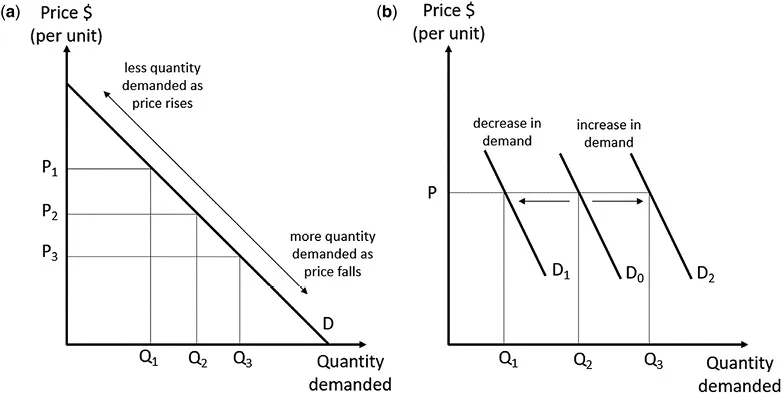![]()
TOURISM DEMAND AND SUPPLY
![]()
CHAPTER 1
THE DEMAND FOR TOURISM
LEARNING OBJECTIVES
After reading this chapter, you should be able to:
1. Define tourism demand, distinguishing between demand to visit a destination and demand for a particular tourism product.
2. Distinguish the price and non-price determinants of tourism demand.
3. Understand the importance of price elasticity, income elasticity, cross-price elasticity and advertising elasticity of tourism demand.
4. Understand the effects of exchange rate changes on tourism demand.
5. Understand the importance of modelling tourism demand.
6. Identify the various quantitative and qualitative factors that influence the demand for international tourism arrivals.
1.1 INTRODUCTION
Tourism demand refers to the willingness and ability of consumers to buy different amounts of a tourism product at different prices during any one period. The demand for any tourism good or service is influenced by numerous quantifiable and non-quantifiable factors.
1.2 FACTORS INFLUENCING TOURISM DEMAND
The market demand function for a product or service is the relationship between the quantity demanded of the product and the various factors that influence this quantity. For tourism demand, we may distinguish between the demand for travel to a destination (e.g. visitor arrival numbers or expenditure) and the demand for particular tourism-related products or services (e.g. hotel rooms, restaurant meals, sunglasses or cabins on cruise ships).
1.2.1 DEMAND FOR TOURISM
One helpful way to investigate the travel decision is to distinguish two broad determinants of the demand for tourism: price factors and non-price factors.
•Price factors. The cost of tourism to the visitor includes the cost of transport services to and from the destination and the cost of ground content (accommodation, tour services, meals, entertainment and so on). The prices paid by an international tourist who must convert one currency into another are also influenced by prevailing exchange rates.
•Non-price factors. These include socioeconomic and demographic factors such as population, income in origin country, education level, availability of leisure time, migration stock, and qualitative factors such as consumer tastes, tourist appeal, destination image, quality of tourist services, special events, destination marketing and promotion, cultural ties, weather conditions and so on. Non-price factors can have positive or negative effects on tourism demand. Thus, special events tend to boost tourism demand to a destination, while the incidence of terrorism tends to lessen it.
1.2.2 DEMAND FOR A TOURISM PRODUCT
The most important variables affecting the demand for any good or service include its price (Px), consumer income (Y), the number of consumers in the market (N ), the price of related products (substitutes Ps and complements Pc), consumer tastes (T ), level of marketing/promotion expenditure (M), and other variables such as consumer price expectations, interest rates, etc.
We can specify the following general function of the demand for a commodity (Qx) measured in physical units.
Qx = f (Px, Y, N, Ps, Pc, T, M, …) | (1.1) |
The dots at the end of Equation 1.1 refer to any of the determinants of demand that are specific to the particular circumstances of a product or destination. The analyst must not omit important variables from the demand equation. On the other hand, including too many explanatory variables may lead to econometric difficulties and may make it unnecessarily expensive to collect data.
Data can be collected for each of the variables over time (that is, yearly, quarterly, monthly), or for different economic units (individuals, households, origin and so on) at a particular point in time. The former is called ‘time series data’ while the latter is called ‘cross-sectional data’. The type of data used in demand estimation is often dictated by availability. Sources of data for estimating tourism demand can come from a variety of sources including government statistics, industry reports and consumer surveys.
1.2.2.1 Tourism demand and price
A market demand curve is the horizontal summation of individual demand curves. It shows the various quantities of the commodity demanded in the market per unit of time at various alternative prices while holding everything else constant. Changes in the price of a product, holding other things constant, affect the quantity demanded and are represented by a shift along the demand curve.
Economic theory suggests that price and tourism demand have an inverse relationship. As price falls, the quantity demanded for a tourism product or service should rise, and as price rises, the quantity demanded should fall. This is shown in Figure 1.1a.
Figure 1.1 (a) Price changes and quantity demanded, (b) Non-price changes in demand
The inverse relationship between quantity demanded and price (commonly called the law of demand) captures the income effect and substitution effect evident in buyer behaviour.
•Income effect. As the price of a tourism product falls, its price relative to consumer income falls, and consumers can afford more of the product given the same income.
•Substitution effect. Consumers can buy more of the now relatively cheaper tourism product, substituting it for other now relatively more expensive products.
By way of example, as the price of a particular travel destination falls (say a particular promotion reduces the price of airfare/accommodation throughout the USA), persons may undertake more travel to the USA or longer travel or more expensive travel (income effect). Persons may also be inclined to visit the USA rather than other now relatively more expensive destinations (substitution effect).
1.2.2.2 Tourism demand and non-price factors
Following standard theory, if non-price factors change in favour of purchasing a tourism product, demand for that product will increase with more of the product demanded at each price. This could occur if, for example: population increases; average household income increases; preferences change favourably; consumers expect the product’s price to rise shortly; the amount of available leisure time increases; the price of substitute products rises or the price of complementary products falls. Conversely, if non-price factors change to work ag...

